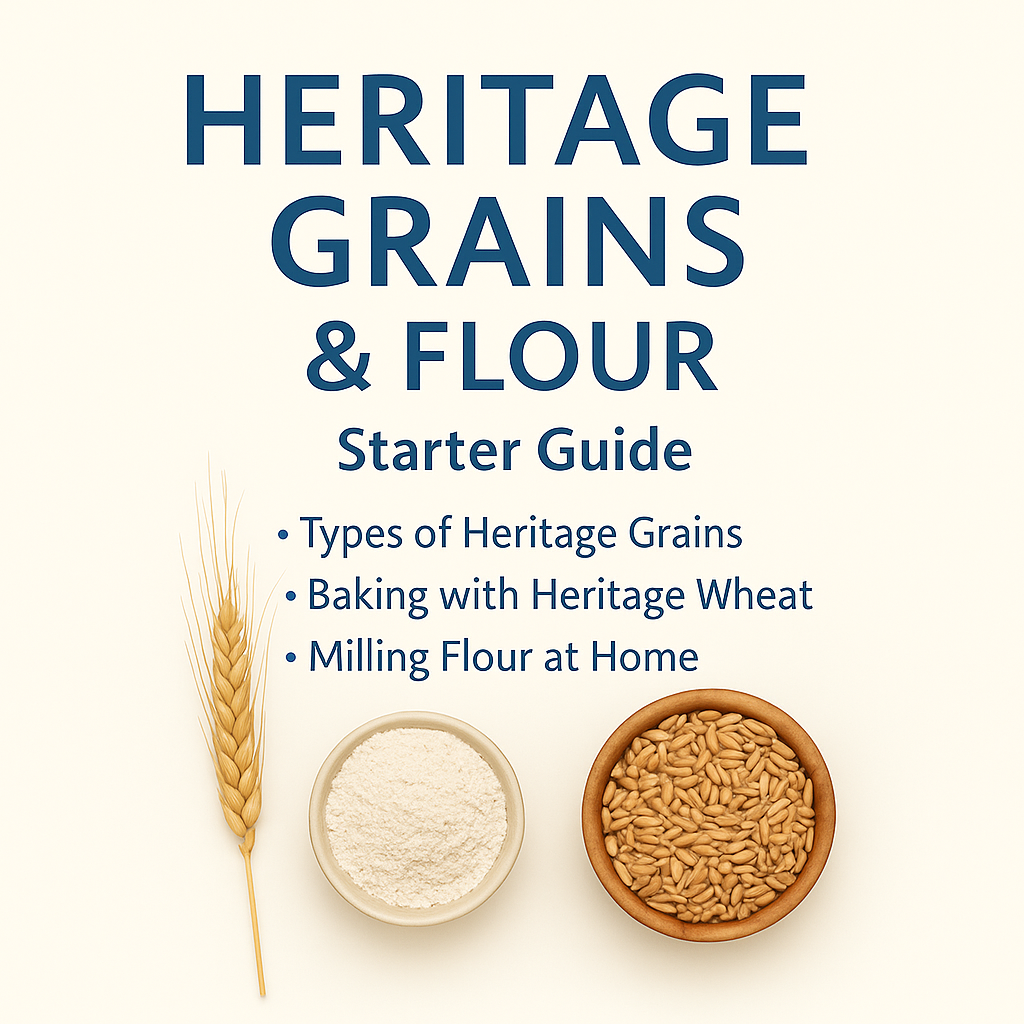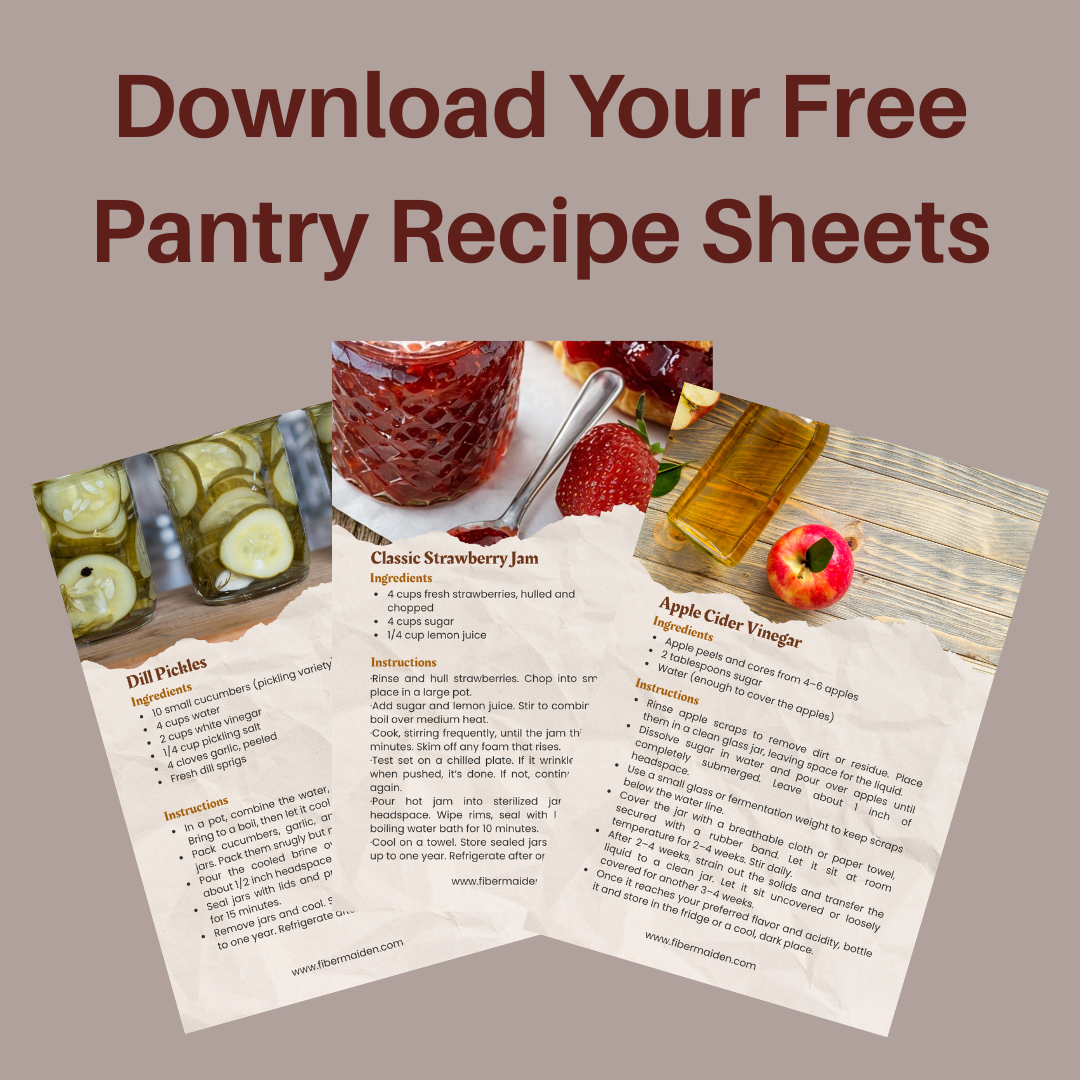Hard White Wheat vs. Einkorn – Baking Texture and Taste Compared
My first attempt at baking with fresh-milled flour was a complete guessing game. I grabbed whatever wheat berries looked good at the store and wondered why my bread turned out like a brick one time and perfect the next. That's when I learned that not all wheat is created equal, and when you're baking with freshly milled flour, choosing the right grain can completely transform your results.
Hard white wheat and einkorn are two beloved pantry staples for home millers, but they behave very differently in baking. Whether you're after a sturdy sandwich loaf or tender muffins, understanding these differences will save you from frustrating failures and inconsistent results. Make sure to check out our free printable Flour & Grain Quick Guide below.
Get The Guide
Ready to stop wondering what grain to buy or how to use it once you mill it? This guide covers heritage grain selection, storage basics, and beginner-friendly techniques for milling and baking with fresh flour. No more staring at wheat berries wondering what comes next, just clear steps and practical tips so you can actually taste the difference fresh-milled flour makes in your kitchen.
Disclosure
Some links on FiberMaiden are affiliate links. When you click and purchase, I may earn a small commission at no extra cost to you. I partner only with brands and tools I trust and use in my own kitchen, studio, and garden. Your support means a lot
What Makes These Grains Different
Hard White Wheat - The Reliable Workhorse Strong gluten structure that creates smooth dough with good rise potential. The flavor is mild and slightly sweet, making it perfect for everyday baking. This grain excels in sandwich bread, dinner rolls, bagels, and pizza dough where you need elasticity and structure. It's ideal for recipes that require the dough to hold its shape and rise predictably.
Einkorn - The Ancient Artisan Soft, delicate texture with lower gluten content that creates moist, tender crumb. The flavor is rich, nutty, and complex in ways that modern wheat can't match. Einkorn shines in muffins, pancakes, quick breads, and rustic loaves where tender texture matters more than structural strength. This grain absorbs less water and doesn't tolerate aggressive kneading.
How They Behave in Your Kitchen
Hard white wheat acts more like the bread flour you're probably familiar with. It's forgiving, predictable, and responds well to traditional bread-making techniques. You can knead it thoroughly, and it will reward you with good rise and structure.
Einkorn requires a gentler approach. The dough will feel stickier and more delicate. Over-kneading destroys its tender character, and it needs less liquid than you'd expect. Use wet hands or a bench scraper for shaping instead of fighting sticky dough with more flour.
Practical Baking Tips
For beginners, start by substituting only one-third of your regular flour with fresh-milled until you understand how these grains behave in your recipes. This gives you a safety net while you learn their personalities.
Hard white wheat makes an excellent everyday flour that balances structure with mild flavor. It plays well with other grains and adapts to most traditional recipes with minor adjustments.
Store all fresh-milled flour in airtight containers in cool, dry places since the oils in whole grain flours can go rancid quickly.
Why Choose These Specific Grains
Hard white wheat offers the reliable structure that home bakers need, with pleasant flavor and light color that doesn't overwhelm other ingredients. It's the grain to choose when you want fresh-milled benefits without dramatically changing your familiar recipes.
Einkorn connects you to ancient grain traditions while delivering superior digestibility, complex flavor, and impressive nutritional density. It's the grain for bakers who want to explore what wheat tasted like before modern breeding programs optimized it for industrial production.
The Real Test
The best way to understand these grains is to bake with both. Try making the same recipe with each grain and compare the results. Your hands will tell you how the dough feels different, and your taste buds will show you which flavors and textures you prefer. There's no substitute for hands-on experience when it comes to understanding how different grains perform in your specific kitchen conditions.
Troubleshooting and Safety
Hard white wheat dough too sticky: Add flour gradually, but don't add too much. Fresh-milled flour continues absorbing liquid as it sits, so let the dough rest 10-15 minutes before deciding if you need more flour.
Einkorn dough falling apart: You're probably over-kneading or using too much liquid. Einkorn needs gentle handling and less hydration than regular wheat. Mix just until ingredients combine, then let time do the work.
Bread not rising properly: Fresh-milled flour can inhibit yeast if it's too fresh or if the grain had any fermentation issues. Let flour rest for a day or two after milling, and make sure your yeast is active and fresh.
Bitter or off flavors: This usually indicates rancid oils from improper storage or old grain. Fresh-milled flour should smell sweet and nutty, not bitter or musty. Store grain properly and mill only what you'll use soon.
Inconsistent results between batches: Different crops of the same grain variety can behave differently. Keep notes on what works with specific batches of grain, and adjust liquid and timing as needed.
Dense, heavy results: Whole grain flours need more liquid and often longer fermentation times than refined flours. Try adding extra liquid gradually and allowing longer rise times for better texture.
Get 3 Free Recipe Sheets
Ready for recipes that don't require a culinary degree to follow? Get seasonal recipe sheets designed for real kitchens and busy lives, the kind that work even when your kids are asking for snacks mid-prep.
Frequently Asked Questions
Grain & Flour Quick Guide
Simple chart and tips for choosing grains, flour types, and blends for fresh milled and store flour.
Best for bread: Hard red or hard white
Best for tender bakes: Soft white
Mild flavor: Hard white • Robust flavor: Hard red
Flatbreads and tortillas: Hard white or a red and white blend
Grain comparison
| Grain | Typical protein | Best for | Flavor notes | Notes |
|---|---|---|---|---|
| Hard Red Wheat | ~12–15% | Yeasted bread, sourdough, pizza, bagels | Nutty, fuller flavor, tan crumb | Strong gluten for rise. Great for 100% whole grain loaves. |
| Hard White Wheat | ~11–14% | Sandwich bread, rolls, tortillas | Mild, slightly sweet, lighter color | Kid friendly flavor with good rise and soft crumb. |
| Soft White Wheat | ~8–10% | Cookies, cakes, muffins, crackers | Delicate, pale crumb | Low gluten. Blend with hard wheat for tall loaves. |
| Einkorn | ~9–12% | Pastry, cookies, quick breads, flatbreads | Buttery, sweet, golden | Weaker gluten. Mix gently. Often lower hydration than modern wheat. |
| Spelt | ~11–15% | Bread blends, pancakes, muffins | Sweet, slightly nutty | Extensible gluten. Handle gently to avoid spread in loaves. |
| Rye | ~7–10% | Rye breads, crackers, blends | Earthy, tangy | Little gluten. Great at 10–40% in blends for flavor and keeping. |
Fresh milled flour tips
- Hydration: plan a bit more water than store flour. Add gradually.
- Autolyse: rest flour and water 20–30 minutes before kneading to soften bran.
- Mixing: shorter knead, more folds. Whole grain tightens if overworked.
- Proofing: whole grain ferments faster. Watch the dough, not the clock.
- Sifting option: sift coarse bran, soak it in a little water, then fold in.
Simple substitutions
- Red and white (hard): swap 1:1. Flavor and color shift slightly.
- Soft white in bread: blend 25–40% soft with hard wheat. Reduce water slightly.
- No bread flour on hand: use hard white or hard red and add a touch more water.
- Einkorn swap: use by itself for cookies and quick bakes or blend 25–50% in bread.
Quick reference
| Use | Best choice | Backup blend |
|---|---|---|
| Everyday sandwich bread | Hard white | 50 50 hard red and hard white |
| Rustic sourdough or pizza | Hard red | 70% hard red + 30% hard white |
| Tender cookies and cakes | Soft white | Soft white + 10–20% hard white |
| Tortillas and flatbreads | Hard white | 60% hard white + 40% soft white |
© FiberMaiden • www.fibermaiden.com








